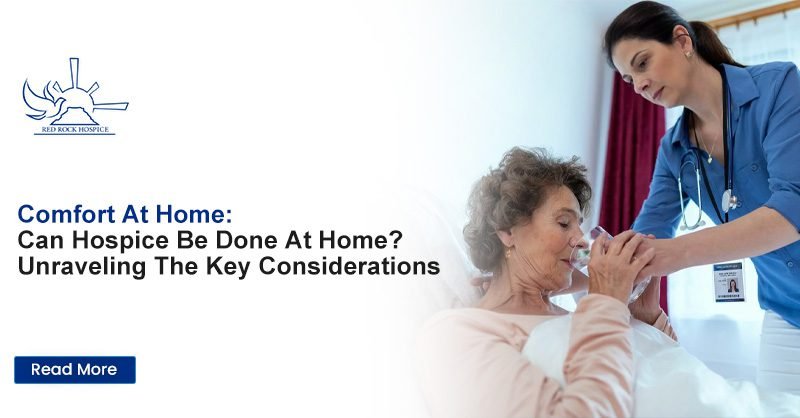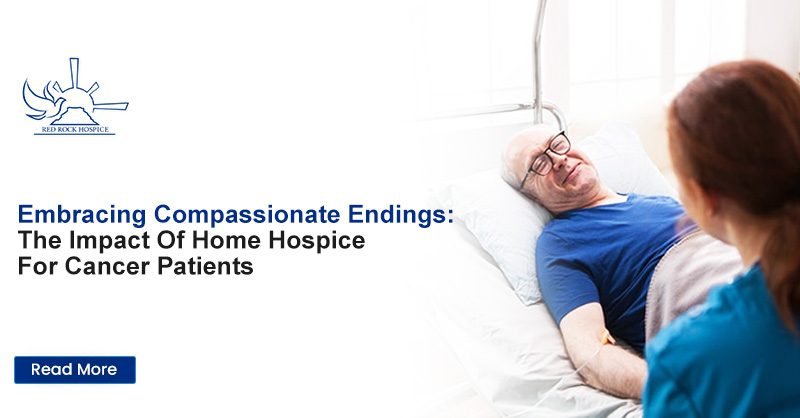In terminal illness, hospice care becomes a beacon of solace, providing medical support, compassion, and understanding. Join us on a journey to understand the mechanics of how hospice works, with a particular focus on Red Rock Hospice’s compassionate approach.
How Hospice Works: A Holistic Overview
At the core of hospice care lies a holistic approach that addresses the physical aspects of a patient’s well-being and emotional and spiritual needs. With its unwavering commitment, Red Rock Hospice exemplifies this holistic philosophy, providing comprehensive end-of-life care.
Holistic Care at Hospices
Hospices understands that terminal illness affects individuals on multiple levels, requiring a comprehensive care strategy. The holistic approach encompasses
Physical Care:
- Qualified Professionals: Hospices employ skilled medical professionals, including nurses, doctors, and aides, to manage pain and symptoms effectively.
- Medication Management: A crucial aspect of hospice care is medication management. Hospices ensure patients receive the appropriate medications to alleviate pain and enhance comfort.
Emotional Support:
- Counseling Services: Recognizing patients’ and their families’ emotional challenges, hospices offer counseling services. Licensed counselors provide a safe space for individuals to express their feelings and concerns.
- Family Involvement: Hospices actively involve family members in the care process, fostering a supportive environment for the patient and their loved ones.
Spiritual Care:
- Chaplain Services: Understanding the significance of spiritual well-being, Hospices provide access to chaplain services. Spiritual care is personalized based on the individual’s beliefs and preferences.
The Numbers Speak: Hospice Care’s Enduring Impact
With the growing need for compassionate end-of-life care, hospice providers make a meaningful difference. Based on industry-wide data, here’s a glimpse into these services’ impact on patients and their families:
Reaching Those in Need
- In 2022, over 485,000 individuals in the United States received hospice care, highlighting the increasing demand for this specialized support.
- This translates to nearly 1,300 patients finding comfort and holistic care daily in these programs.
Empowering Families:
- Hospice recognizes that end-of-life journeys are shared experiences. Beyond patients, over 1.5 million family members received emotional support and guidance from hospice teams.
- This comprehensive approach acknowledges collective grief and helps families navigate uncertainties confidently.
Holistic Outcomes:
- Studies show that hospice care demonstrably improves the quality of life for patients and their families.
- Up to 90% of hospice patients report improved pain management and symptom control, leading to greater comfort and peace.
- Additionally, over 80% of families credit hospice with reducing anxieties and fostering emotional well-being during this challenging time.
These numbers underscore the invaluable role hospice plays in navigating end-of-life journeys. Through compassionate care, patient-centered approaches, and unwavering support for families, hospice empowers individuals and their loved ones to face challenging times with dignity and grace.
Collaborative Care Planning at Red Rock Hospice
One of the distinctive features of Red Rock Hospice is its emphasis on collaborative care planning:
- Interdisciplinary Meetings: The care team at Red Rock Hospice engages in multidisciplinary meetings to discuss and tailor care plans. This collaborative approach ensures that every patient’s needs are comprehensively addressed.
- Patient and Family Input: Red Rock Hospice actively seeks patient and family input in care planning, respecting individual preferences and values.
Eligibility for Hospice Care: Navigating the Admission Process
As individuals and their families face the challenging prospect of hospice care, understanding the eligibility criteria becomes a pivotal step. Red Rock Hospice, committed to accessible and compassionate care, navigates the admission process.
Navigating Hospice Admission: The Initial Steps
1. Medical Certification:
Individuals need a medical certification from a qualified physician to qualify for hospice care. This certification verifies that the patient has a life-limiting illness and their prognosis is within a specific timeframe, often six months or less.
2. Acceptance of Palliative Care:
Hospice care is fundamentally palliative, focusing on providing relief from pain and symptoms rather than curative treatment. Patients must be willing to shift from curative treatment to palliative care to be eligible for hospice.
3. Prognosis Evaluation:
Physicians assess patients’ prognoses based on their medical condition and history. This evaluation helps determine if the individual meets the criteria for hospice care.
4. Informed Decision-Making:
Hospice admission is a collaborative decision between the patient, their family, and the healthcare team. Individuals need to be informed about the nature of hospice care, including its benefits and limitations.
Hospice Care: Streamlining the Admission Process
1. Compassionate Consultations:
Hospice care provides compassionate consultations to help individuals and their families understand the hospice care approach. This includes discussing the transition from curative to palliative care.
2. Timely Documentation:
Hospices ensure timely documentation of the necessary medical certifications and evaluations to facilitate admission. This streamlined approach minimizes delays, allowing patients to access care promptly.
3. Patient Advocacy:
The hospice serves as a patient advocate during the admission process, addressing concerns, providing clear information, and respecting patients’ choices and preferences.
Eligibility Beyond Medical Conditions
1. Diverse Diagnoses:
While terminal illness is a primary consideration, hospice care is not limited to specific diseases. Hospice accommodates a diverse range of diagnoses, recognizing that each patient’s journey is unique.
2. Age Consideration:
Hospice care is available for individuals of all ages, including pediatric patients. Hospices tailor their services to meet the unique needs of patients across different age groups.
Tailored Care Plans: Personalizing Comfort for Each Individual
At Hospices, the commitment to providing personalized and compassionate care is exemplified by creating tailored care plans. Understanding that each individual’s journey is unique, our approach focuses on addressing specific needs, ensuring comfort, and enhancing the quality of life.
Personalized Assessments: A Holistic Approach
1. Comprehensive Health Evaluation:
The hospice team conducts a thorough health assessment, considering the patient’s medical condition and emotional, social, and spiritual well-being. This comprehensive evaluation forms the foundation for crafting a personalized care plan.
2. Individualized Symptom Management:
Hospice care centers understand that patient symptoms can vary. That’s why it creates customized care plans that prioritize effective interventions for pain, nausea, and emotional distress.
3. Emotional and Spiritual Support:
Our care plans encompass emotional and spiritual dimensions beyond physical well-being. Hospices understand the significance of addressing psychological and spiritual needs, and our team works collaboratively to offer support that aligns with each individual’s beliefs and preferences.
Incorporating Patient Preferences: A Collaborative Approach
1. Open Communication Channels:
Hospices emphasize open communication with patients and their families. Through conversations, preferences and care goals are identified, allowing us to tailor our approach accordingly..
2. Involvement in Decision-Making:
Patients actively participate in decisions regarding their care. This collaborative approach ensures that the care plan aligns with their preferences, promoting a sense of control and dignity.
Flexibility and Adaptability: Responding to Evolving Needs
1. Regular Reassessments:
Recognizing that this needs to evolve, our care plans undergo regular reassessments. This ensures that interventions remain aligned with the current health status and any changes in the patient’s preferences.
2. Family Involvement:
Hospices value the role of family members in the care process. We actively involve families in discussions and decision-making, ensuring that the care plan reflects the collective understanding of the patient’s needs.
Conclusion: Hospices – Nurtures Comfort Through Every Step
In terminal illness, hospice care is a beacon of solace, offering medical support, compassion, and understanding. The mechanics of how hospice works, particularly in the compassionate approach of Red Rock Hospice, unravel a holistic journey that addresses the physical, emotional, and spiritual aspects of a patient’s well-being.
Red Rock Hospice is a testament to unwavering compassion and support in hospice care. Understanding how hospice works sheds light on the dedication to providing comfort in every step of the challenging journey toward the end of life.
Embark on this insightful exploration of how hospice works, uncovering the distinctive approach of Red Rock Hospice in ensuring that every individual receives comfort, compassion, and dignity throughout their end-of-life journey.
FAQs (Frequently Asked Questions) – Understanding the Mechanics of Hospice Care:
1. What is the holistic approach in hospice care, and how does Red Rock Hospice exemplify it?
Hospice care adopts a holistic approach that addresses patients’ physical, emotional, and spiritual needs. Red Rock Hospice exemplifies this philosophy by employing skilled medical professionals, providing counseling services, actively involving family members, and offering chaplain services for spiritual care.
2. According to industry-wide data, How does hospice care impact patients and their families?
Hospice care has a significant impact, with over 485,000 individuals receiving care in the United States in 2022. Beyond patients, over 1.5 million family members received emotional support and guidance. Studies indicate up to 90% of hospice patients experience improved pain management and symptom control, contributing to greater comfort and peace for families.
3. What sets Red Rock Hospice apart in terms of care planning?
Red Rock Hospice emphasizes collaborative care planning through interdisciplinary meetings, ensuring comprehensive care plans that address individual patient needs. They actively seek patient and family input, respecting personal preferences and values in planning.
4. What are the initial steps and eligibility criteria for hospice admission?
Hospice admission involves a medical certification from a qualified physician, acceptance of palliative care, a prognosis evaluation, and informed decision-making. Red Rock Hospice facilitates the admission process through compassionate consultations, timely documentation, and acting as a patient advocate.
5. Is hospice care limited to specific medical conditions or age groups?
Hospice care is not limited to specific diseases or age groups. It accommodates diverse diagnoses, recognizing the uniqueness of each patient’s journey. This inclusive approach ensures personalized and compassionate care for individuals of all ages.
6. How are care plans personalized in hospice care, and what role do patients play in decision-making?
Hospices create tailored care plans through comprehensive health evaluations, individualized symptom management, and emotional/spiritual support. Open communication channels and active involvement of patients in decision-making ensure that care plans align with preferences, promoting a sense of control and dignity.
7. How does hospice care respond to evolving needs and involve families?
Hospice care remains flexible and adaptable through regular reassessments. Family involvement is valued, with families actively participating in discussions and decision-making. This collaborative approach ensures that care plans evolve with changing health status and patient preferences.







